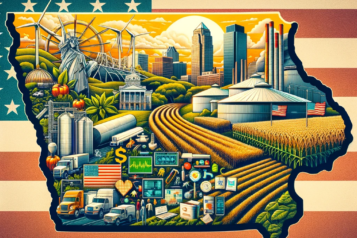In the heartland of America, Iowa stands as a testament to the potential of renewable energy. The state is a leader in wind power generation, yet the transition to a fully renewable energy system faces significant obstacles. From technological to economic, and from social to political, these challenges are as diverse as they are daunting.
Technological Barriers
Iowa’s renewable energy sector is predominantly wind-based. However, the intermittency of wind poses a technological challenge. Energy storage technologies, such as batteries, are still in their infancy and are not yet capable of storing the vast amounts of power generated on windy days for use during calmer periods. Moreover, the existing grid infrastructure was designed for steady power sources and requires substantial upgrades to handle the variable outputs from renewable sources.
Economic Hurdles
The initial investment in renewable energy infrastructure is substantial. While wind turbines dot the Iowa landscape, the upfront costs of these installations are significant. Furthermore, the economic viability of renewable energy is often questioned, as the fossil fuel industry has established deep financial roots in the state, providing tax revenue and jobs that renewables have yet to match.
Social Obstacles
Social acceptance of renewable energy varies widely across Iowa. While some communities embrace wind farms, others are concerned about the visual and auditory impact on the landscape. The “not in my backyard” syndrome is a real phenomenon, posing a hurdle for new projects. Additionally, there is a need for education and training to equip the workforce with the skills needed for jobs in the renewable energy sector.
Political Roadblocks
The transition to renewable energy is not just a technological or economic issue; it is deeply political. In Iowa, there is a delicate balance between supporting renewable initiatives and maintaining the status quo of agricultural and fossil fuel interests. Subsidies for renewable energy have been a contentious issue, with debates often split along party lines.
Environmental Concerns
Renewable energy is often seen as a panacea for environmental issues, but it too has an ecological footprint. Wind turbines, for instance, have been linked to bird and bat fatalities. The production and disposal of renewable energy technologies also have environmental impacts that must be considered and mitigated.
The Way Forward
Despite these challenges, Iowa’s commitment to renewable energy remains strong. Efforts to improve energy storage, grid modernization, and public engagement are ongoing. Policies aimed at easing the economic transition for communities and workers dependent on fossil fuels are being discussed.
Public-private partnerships are also emerging as a key strategy to finance the renewable transition. These collaborations aim to leverage private investment with public funds and tax incentives to drive the growth of renewable energy.
Conclusion
Iowa’s journey towards a renewable energy future is emblematic of the broader challenges facing the nation. The path is neither straight nor easy, but it is necessary. As Iowa continues to navigate these challenges, it serves as both a leader and a laboratory for the rest of the country. The lessons learned here will be vital in guiding America towards a sustainable and energy-independent future.














